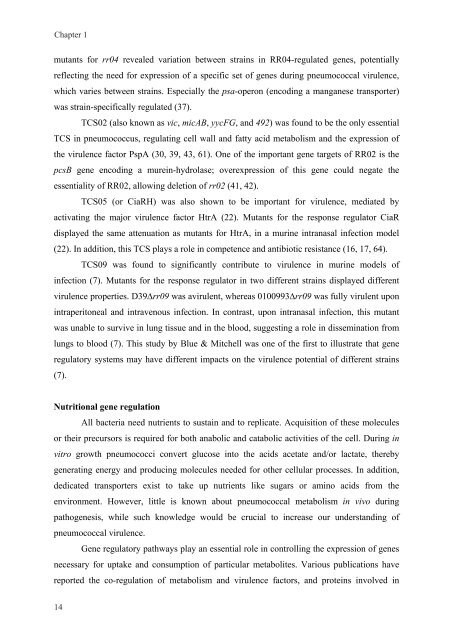Gene regulation in Streptococcus pneumoniae - RePub - Erasmus ...
Gene regulation in Streptococcus pneumoniae - RePub - Erasmus ...
Gene regulation in Streptococcus pneumoniae - RePub - Erasmus ...
Create successful ePaper yourself
Turn your PDF publications into a flip-book with our unique Google optimized e-Paper software.
Chapter 1<br />
mutants for rr04 revealed variation between stra<strong>in</strong>s <strong>in</strong> RR04-regulated genes, potentially<br />
reflect<strong>in</strong>g the need for expression of a specific set of genes dur<strong>in</strong>g pneumococcal virulence,<br />
which varies between stra<strong>in</strong>s. Especially the psa-operon (encod<strong>in</strong>g a manganese transporter)<br />
was stra<strong>in</strong>-specifically regulated (37).<br />
14<br />
14<br />
TCS02 (also known as vic, micAB, yycFG, and 492) was found to be the only essential<br />
TCS <strong>in</strong> pneumococcus, regulat<strong>in</strong>g cell wall and fatty acid metabolism and the expression of<br />
the virulence factor PspA (30, 39, 43, 61). One of the important gene targets of RR02 is the<br />
pcsB gene encod<strong>in</strong>g a mure<strong>in</strong>-hydrolase; overexpression of this gene could negate the<br />
essentiality of RR02, allow<strong>in</strong>g deletion of rr02 (41, 42).<br />
TCS05 (or CiaRH) was also shown to be important for virulence, mediated by<br />
activat<strong>in</strong>g the major virulence factor HtrA (22). Mutants for the response regulator CiaR<br />
displayed the same attenuation as mutants for HtrA, <strong>in</strong> a mur<strong>in</strong>e <strong>in</strong>tranasal <strong>in</strong>fection model<br />
(22). In addition, this TCS plays a role <strong>in</strong> competence and antibiotic resistance (16, 17, 64).<br />
TCS09 was found to significantly contribute to virulence <strong>in</strong> mur<strong>in</strong>e models of<br />
<strong>in</strong>fection (7). Mutants for the response regulator <strong>in</strong> two different stra<strong>in</strong>s displayed different<br />
virulence properties. D39∆rr09 was avirulent, whereas 0100993∆rr09 was fully virulent upon<br />
<strong>in</strong>traperitoneal and <strong>in</strong>travenous <strong>in</strong>fection. In contrast, upon <strong>in</strong>tranasal <strong>in</strong>fection, this mutant<br />
was unable to survive <strong>in</strong> lung tissue and <strong>in</strong> the blood, suggest<strong>in</strong>g a role <strong>in</strong> dissem<strong>in</strong>ation from<br />
lungs to blood (7). This study by Blue & Mitchell was one of the first to illustrate that gene<br />
regulatory systems may have different impacts on the virulence potential of different stra<strong>in</strong>s<br />
(7).<br />
Nutritional gene <strong>regulation</strong><br />
All bacteria need nutrients to susta<strong>in</strong> and to replicate. Acquisition of these molecules<br />
or their precursors is required for both anabolic and catabolic activities of the cell. Dur<strong>in</strong>g <strong>in</strong><br />
vitro growth pneumococci convert glucose <strong>in</strong>to the acids acetate and/or lactate, thereby<br />
generat<strong>in</strong>g energy and produc<strong>in</strong>g molecules needed for other cellular processes. In addition,<br />
dedicated transporters exist to take up nutrients like sugars or am<strong>in</strong>o acids from the<br />
environment. However, little is known about pneumococcal metabolism <strong>in</strong> vivo dur<strong>in</strong>g<br />
pathogenesis, while such knowledge would be crucial to <strong>in</strong>crease our understand<strong>in</strong>g of<br />
pneumococcal virulence.<br />
<strong>Gene</strong> regulatory pathways play an essential role <strong>in</strong> controll<strong>in</strong>g the expression of genes<br />
necessary for uptake and consumption of particular metabolites. Various publications have<br />
reported the co-<strong>regulation</strong> of metabolism and virulence factors, and prote<strong>in</strong>s <strong>in</strong>volved <strong>in</strong>

















